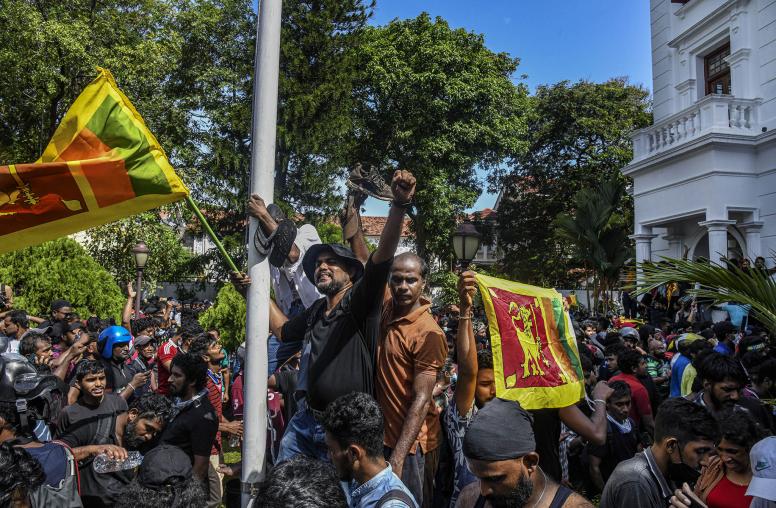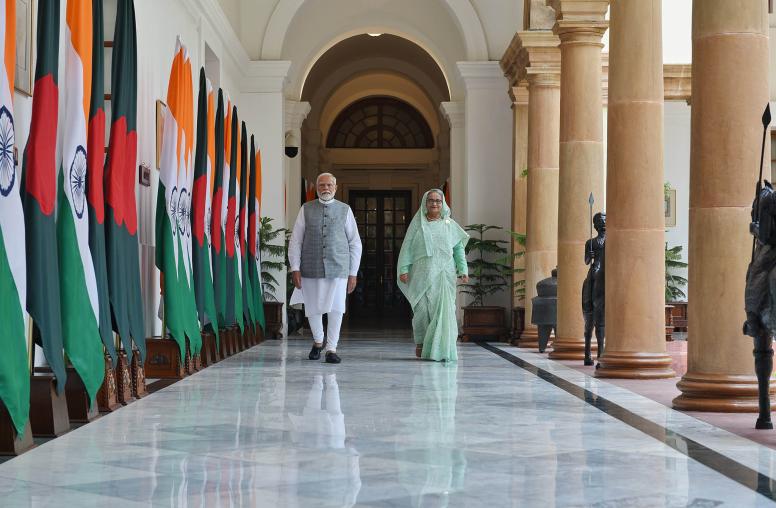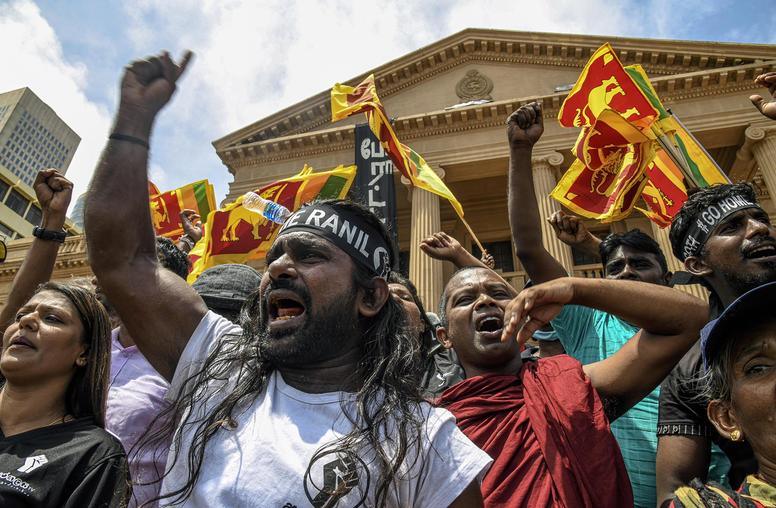Indian Ocean Basing and Access: How Smaller States Navigate Major Power Competition
A new policy in Sri Lanka shows how smaller states play a crucial role in deciding major powers’ military access to the region.
In late July, Sri Lankan President Ranil Wickremesinghe traveled to New Delhi to meet with Indian Prime Minister Narendra Modi. The trip addressed several important issues, such as greater connectivity. However, there was one item on the agenda that did not receive much media attention despite its potential impact on Indian Ocean regional security: Sri Lanka’s new standard operating procedure (SOP) to determine which military and non-military ships and aircraft may visit the country.

Sri Lanka began developing the SOP after a Chinese satellite- and missile-tracking ship named the Yuan Wang 5 made a controversial visit to the southern Sri Lankan port of Hambantota in August 2022. India reportedly requested such an SOP amid its own heightened (and deadly) border dispute with China — but it is far from the only major power interested in clarity regarding access to strategic ports in smaller South Asian states. Developments like those in Sri Lanka have wider implications for major powers’ access to the Indian Ocean as smaller states figure out how to navigate geopolitical competition in the region.
The Forgotten Role of Smaller South Asian States in Indian Ocean Basing and Access
Sri Lanka has long served as a stopover for commercial, civilian and military ships because of its location along the main east-west sea lanes in the central Indian Ocean. Colombo’s port is consistently the highest-ranked South Asian port in Lloyd’s List of 100 container ports, even after the country’s 2022 crisis.
Regarding military access, Sri Lanka played a critical role in the tectonic shifts regarding Indian Ocean basing in the early decades of the Cold War. After non-aligned politicians in Sri Lanka (formerly known as Ceylon) won elections in 1956, the new leadership called for the United Kingdom to vacate its naval and air bases in the country. Colombo’s policy shift revealed how a smaller state’s political decisions can affect the calculus of large powers’ strategic ambitions.
As a result of this move by one smaller South Asian country, the U.K. looked for basing in Maldives — another smaller South Asian country. London received initial concurrence to resurrect its wartime base in southern Maldives and eventually completed its construction. However, the obstacles presented by a successor government led both the U.K. and its alliance partner, the United States, to prioritize alternate military basing due to the uncertain state of relations with regional countries.
They soon identified Diego Garcia as a location in the Chagos Islands. The pursuit of a basing facility involved improperly decolonizing Mauritius and expelling the local Chagossian population — decisions that are still a source of major controversy.
Today, the Diego Garcia base faces challenges. Despite being a smaller state, Mauritius has waged an increasingly successful legal and diplomatic battle with the U.K. for control of the Chagos Islands. At the same time, Mauritius has experienced the limits of international law and diplomacy: The U.K. — and by extension, the United States — still have military forces present on Diego Garcia. The dispute entered a new phase in November 2022, when the U.K. agreed to bilateral discussions with Mauritius to find a resolution.
Those negotiations remain underway, and the varying abilities of smaller states such as Mauritius, Maldives and Sri Lanka in setting the parameters for military basing and access in the Indian Ocean have major implications for how the United States and its allies should approach the issue going forward.
Hambantota Ship Visit
When the Yuan Wang 5 entered Hambantota in August 2022, it caused a diplomatic and media storm. China has increasingly become an extaregional country of concern for its activities in the Indian Ocean. Five years after a Chinese-majority joint venture agreed to pay roughly $1 billion to lease Hambantota port, Sri Lanka’s government appeared to finally permit a Chinese ship to visit to the Chinese built-and-financed port.
The Sri Lankan government had previously permitted military ships and aircraft from other extraregional countries to visit Hambantota, such as from the United States, Russia and Japan. But the Chinese ship’s forthcoming arrival saw officials from India, and reportedly the United States, asking Sri Lanka to rescind diplomatic clearance for the visit, which had been approved the day before the former president, Gotabaya Rajapaksa, fled the country. India-China tensions have escalated in recent years due to the countries’ border conflict, and India was concerned about a Chinese ship visiting Hambantota for the first time, especially a satellite- and missile-tracking ship.
As a smaller state confronting an asymmetry of power, Sri Lanka conducted frantic diplomacy with India, China and the United States and appeared to reach a compromise: The visit took place, but five days later than planned.
Already mired in economic and political crises, this additional diplomatic crisis for Sri Lanka underscored the diminishing space for a smaller state’s agency in pursuing its foreign policy preferences against the backdrop of growing strategic competition in the Indo-Pacific. Since independence, Sri Lanka has largely been able to maintain autonomy in the conduct of port operations. The ports are an important dimension of Sri Lanka’s foreign policy, which is traditionally rooted in a maritime strategic culture of openness that sees value in offering port services to most vessels and crews after passing a vetting process.
Consider, for example, Sri Lanka’s approach to U.S. port visits in the 1970s. At the time, the United States was the extraregional power of concern in the Indian Ocean. At the time, the United States and India had far from the soaring relations we’ve seen recently during Prime Minister Modi’s trip to the United States, and India objected to the U.S. presence in Diego Garcia. Yet, Colombo was one of a handful of ports that offered U.S. ships access to fuel and other supplies at a time when many Indian Ocean ports were closed to the U.S. Navy. Despite being a key actor in the Non-Aligned Movement, Sri Lanka was still willing to provide access to U.S. ships transiting the long distances of the Indian Ocean.
Indian Ocean Access: Back to the Future?
Sri Lanka’s new SOP, the growing India-China and U.S.-China rivalries, the historical role of smaller South Asian countries during the Cold War, and ongoing discussions between Mauritius and the U.K. about the Chagos Islands all remind observers of the importance of smaller states in providing basing and access for major powers.
Beyond the Indian Ocean, U.S. Secretary of Defense Lloyd Austin’s recent trip to Papua New Guinea illustrates the need for greater U.S. and allied access across the vast Indo-Pacific region. Yet, while smaller states may appear to be gaining leverage with greater attention, their room for flexibility in conducting their preferred foreign policy is often limited due to their need for resources to address economic development objectives and non-traditional security concerns.
In the Indian Ocean, a big question going forward is how will Sri Lanka implement the new SOP when reviewing China’s requests for port visits? Will Sri Lanka follow a path similar to the one it charted during the Cold War? Then, it was willing to permit ship visits by the United States as an extraregional power, despite India’s preferences. Or will it decide that no Chinese military or state-owned ship visit is worth the diplomatic and economic consequences?
Since the fallout over India’s reaction to Chinese submarine visits in 2014, Sri Lanka has not permitted another Chinese submarine to visit its ports. Reuters even reported that Sri Lanka denied a request from China in 2017.
Given Sri Lanka’s economic and political crises over the past year, the country is now in a more difficult position because it depends on India’s help to recover economically and relies on India for strong maritime security cooperation.
Furthermore, if Sri Lanka decides to stop providing access to China’s government and military ships, will China seek stopovers elsewhere, such as in Maldives? Could this smaller South Asian state once again fulfill a critical role in providing access to large powers in the central Indian Ocean? Under the current leadership of President Ibrahim Mohamed Solih, this outcome does not seem likely. However, the two previous administrations permitted Chinese naval ship visits. Maldives is scheduled to have a presidential election next month, and the outcome is far from clear at present. Like Sri Lanka, Maldives has faced challenges as a smaller state in managing the pressures from the China-India rivalry.
One development, however, that is not in question is that Chinese ships will continue to deploy to the Indian Ocean, with new types to come. Just this week, there are reports of a Chinese ship visiting Colombo port. U.S. policymakers could consider increasing the provision of maritime security resources to smaller states in the Indian Ocean, which consistently seek greater technical capacity for managing their ports. Sri Lanka already has a longstanding relationship with the U.S. Coast Guard’s International Port Security Program, whose team is currently in the country providing support to the Sri Lanka Navy and Sri Lanka Ports Authority.
The long-term implications of Sri Lanka’s new SOP are not yet known, but the SOP itself will be tested over the coming years. Policymakers should consider what port visits they will see from China — and what they will not see — as smaller states grapple with how to assert their own agency amid growing strategic competition.



